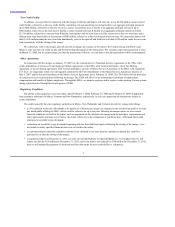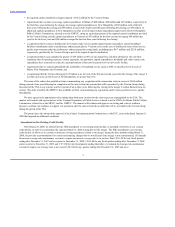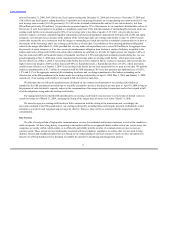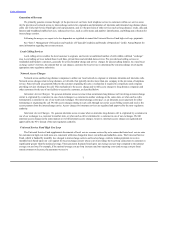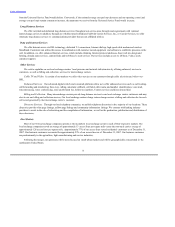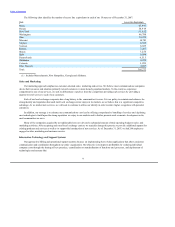FairPoint Communications 2007 Annual Report Download - page 16
Download and view the complete annual report
Please find page 16 of the 2007 FairPoint Communications annual report below. You can navigate through the pages in the report by either clicking on the pages listed below, or by using the keyword search tool below to find specific information within the annual report.
Table of Contents
increases and our operating costs and average cost per loop remain constant or decrease, the payments we will receive from the Universal
Service Fund will decline. Based on historical trends, we believe the total payments from the Universal Service Fund to our existing rural
operations likely will continue to decline.
Universal Service Fund disbursements may be distributed only to carriers that are designated as “eligible telecommunications
carriers” by a state regulatory commission. Following the transactions, all of our non-rural and rural local exchange carriers will be
designated as eligible telecommunications carriers. However, under current regulations, competitors can obtain the same per-line support
payments as we do, if a state regulatory commission determines that granting such support is in the public interest.
The FCC is currently considering revisions to the distribution mechanisms for Universal Service Fund high-cost support. The
proposals under consideration include using “reverse auctions” to determine recipients of rural high-cost support and creating separate
funds for wireless, broadband, and “carriers of last resort,” which might be the incumbent local exchange carrier. These and other
proposed rule changes could reduce our support in the future, reduce the support available to our competitors or provide for new support,
such as for broadband services. We cannot predict what course the FCC will take on universal service distribution reform, but it is
possible that the remedy selected by the FCC could materially affect the amount of universal service funding we will receive. If our
existing rural local exchange carriers were unable to receive Universal Service Fund payments, or if those payments were reduced, many
of our rural local exchange carriers would be unable to operate as profitably as they have historically in the absence of the implementation
of increases in charges for other services. Moreover, if we raise prices for services to offset loss of Universal Service Fund payments, the
increased pricing of our services may disadvantage us competitively in the marketplace, resulting in additional potential revenue loss.
Following the transactions, we will receive additional support under the FCC’s rules in the forms of Interstate Access Support and
Interstate Common Line Support. We will receive Interstate Access Support in all three of our price cap study areas (Maine, New
Hampshire and Vermont). We will also continue to receive Interstate Common Line Support in our rate-of-return study areas. These forms
of support replace revenues previously collected through interstate access charges. We will have no assurance that these support programs
will remain unchanged if the FCC revises its rules governing universal service and inter-carrier compensation.
Federal universal service programs are currently funded through a surcharge on interstate and international end-user
telecommunications revenues. Declining long-distance revenues, the popularity of service bundles that include local and long-distance
services, and the growth in size of the fund, due primarily to increased funding to competitive eligible telecommunications carriers, all
prompted the FCC to consider alternative means for collecting this funding. As an interim step, the FCC has ordered that providers of
certain VoIP services must contribute to federal universal service funding. The FCC also increased the percentage of revenues subject to
federal universal service contribution obligations that wireless providers may use as their methodology for funding universal service. One
alternative under active consideration would be to impose surcharges on telephone numbers or network connections instead of carrier
revenues. Any further change in the current assessment mechanism could result in a change in the total contribution that local telephone
companies, wireless carriers or others must make and that would be collected from customers. We cannot predict whether the FCC or
Congress will require modification to any of the universal contribution rules, or the ultimate impact that any such modification might
have on us.
The 1996 Act provides, in general, for the removal of barriers to market entry in order to promote competition in the provision of
local telecommunications services. As a result, competition in our local exchange service areas will continue to increase from competitive
local exchange carriers, wireless providers, cable companies, Internet service providers, electric companies and other providers of network
services. Many of these competitors have a significant market presence and brand recognition, which could lead to more competition and
a greater challenge to our future revenue growth.
14


